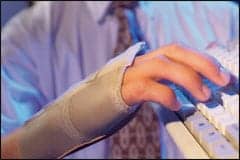 |
A functional capacity evaluation (FCE) is a very useful and effective tool in work-injury management. FCEs can assist in case closure, help identify work restrictions, enhance marketing and clinic profitability, and identify opportunities for the therapy clinic to market and offer additional work-injury-management services. All of these reasons make FCE programs an important and valuable service for the therapy provider.
A facility can implement an FCE program and augment its worker-rehabilitation skilled therapy programs and services by offering the employer, physician, and insurance carrier a clinical tool to evaluate return-to-work readiness and any potential work restrictions. FCE services can provide a therapy clinic with additional marketing opportunities. Physicians and insurance carriers are always looking for assistance with determining return-to-work readiness and restriction for injured workers. In addition, an FCE may show that additional work-injury-management services are indicated for an injured worker to ensure a safe and appropriate transition back to work. These additional services include ergonomic assessments, work-injury-containment programs, return-to-work programs, and work-integration programs.
FCEs are typically reimbursed well due to the high level of testing, interpretation, and clinical skill required. Most FCEs are reimbursed according to state fee schedule or payor contracts. The reimbursement varies from state to state, but it will enhance a therapy provider’s bottom line profitability.
GETTING STARTED
Advanced clinical training in the form of continuing education and certification programs is recommended for the therapist interested in performing FCEs. Strong clinical skills in functional assessment and FCE test interpretation are required. In fact, some states, such as California, even require that the therapist demonstrate advanced training in FCEs prior to performing an FCE.
Several FCE training and certification programs are available in the market. These programs vary slightly in method of testing maximal abilities, report formatting, software requirements, and testing philosophies. A clinician should evaluate which FCE testing method they are most comfortable with and, in some cases, obtain advanced training in FCEs to increase their knowledge in these high-level clinical tests.
THE BENEFITS OF FCE
Throughout the evolution of FCE testing, the methods and interpretations of FCEs have received both criticism and praise. The majority of return-to-work determinations do not require extensive functional-capacity testing and documentation. However, when return-to-work decisions and worker capacities are questionable, an FCE has proven to facilitate the return-to-work process and case closure.
The FCE can provide a cost-efficient tool in prompting return-to-work solutions and case closure if workers’ compensation claims remain open due to questionable return-to-work issues. In addition, if it is determined that a worker is not capable of returning to their preinjury level of work, the FCE can facilitate the involvement of vocational rehabilitation and retraining. There are many benefits of FCEs, including injury reduction, solving return-to-work issues, and cost containment with facilitation of case closure. Other benefits may include preventing further injury or reinjury by identifying safe, work-specific limitations and capabilities.
APPLICATIONS AND INDICATIONS
FCEs provide a method to objectively and safely quantify the safe functional abilities of an individual following a musculoskeletal injury or illness. Applications and indications for an FCE in work-injury management include:
- determination of work function or work level with nonwork-related illnesses and injuries;
- determination of work function or work level with work-related illnesses and injuries;
- return-to-work and job-placement decisions and programs;
- disability evaluation and rating;
- determination of function in nonoccupational settings;
- medical and rehabilitation treatment intervention and planning; and
- case management and case closure.
The FCE provides medical and rehabilitation professionals, the insurance carrier, and the employer with valuable information, which is relevant not only to the injured worker’s condition but also to work-specific abilities. FCEs can result in return to work, case closure, the identification of work restrictions. or the identification of potential treatments for the injured worker, such as a return-to-work program. All of these results help achieve the primary goal in worker rehabilitation: enabling the injured worker to return to work.
FCE TESTING CRITERIA
In work-injury management, FCEs are often used in case closure and may end in court decisions. Therefore, it is critical that FCEs are reliable and valid. For FCE tests to be reliable and valid, the following FCE criteria must be met:
- Objectivity. Objectivity refers to the indication that the test measurements are relatively unbiased by either the participant or the evaluator. Objectivity in testing can be increased when the testing procedures and practices for observation and scoring are clearly defined and documented.
- Reliability. Reliability refers to consistency in measurement and scoring. The test measures and scores must be consistent across evaluators, participants, and the date or time of test administration. Inter-rater and Intra-rater reliability have been noted to be the two most important forms of reliability in FCE test administration and evaluation.1
- Inter-rater Reliability. Inter-rater reliability refers to the ability to achieve similar test results on an evaluation when administered by separate evaluators. It ensures that the FCE scores were not due to differences in the evaluator’s skills, test administration, and scoring techniques. Inter-rater reliability can be measured by having two or more different evaluators give a test independently to the same test participant or group of subjects. The test scores are then compared against the others by calculating the coefficient of variation. Ideally, the coefficient of variation should be less than 5%.
- Intra-rater Reliability. Intra-rater reliability refers to the stability of a test score derived from the implementation of one test to another when the same evaluator administers the FCE test. Factors that potentially affect the consistency of test-taking with the same evaluator include: the duration of time between the two tests, the treatments received by the participants, the medical stability of the participants’ conditions, and the cooperation of each of the test participants.
- Practicality. Practicality refers to the reasonableness of the testing procedure. The test must be practical to administer. The direct and indirect costs of the evaluation procedure must be reasonable and appropriate.
- Safety. Safety refers to the level of risk in performing the test. The test must be safe to administer. The FCE must not be expected to lead to injury.
- Utility. Utility refers to the test being useful. The evaluation procedure must meet the needs of, and provide useful information to, the participant, the evaluator, the referral source, and the payor. The FCE must include useful information about specific return-to-work questions.
- Validity. Validity measures how real the test results are. A score is considered valid if it accurately measures the factor it intends to measure, and if it can be used to estimate or reflect performance on a target task. With regard to FCE testing, the functional test scores and measures can estimate and predict real-world function and the ability to perform work-specific tasks and activities. Without validity testing, there is no way of knowing whether the results are truly accurate and meaningful. Validity is an essential requirement of all FCE measurements.2
COMPONENTS OF FCE TESTING
The first task in FCE test administration is to identify the primary objective of the FCE test, which typically comes from the referral source. The referral source has a question to answer, and the FCE test’s objective is to answer that specific question. Once this objective is determined, the examiner can choose the appropriate subtests and measurements.
The FCE test’s components are chosen to meet the specific referral question and needs of the individual client and test participant. The test components assess the ability or inability of the individual’s physiological systems to meet the physical demands of workload and task performance.
Essentially, the FCE test components are developed based on the knowledge base of human physiology, the principles of work, and the physiological responses to work and task-performance requirements. The physiological systems in question include the cardiopulmonary system, the neuromuscular system, the integumentary system, and the vascular system.
The five recommended test components to the FCE are:
- intake interview;
- subjective test;
- neuromusculoskeletal evaluation;
- baseline functional test; and
- work-specific test.
The test components must simulate or involve actual work task requirements for the FCE to be a valid, reliable, objective, and practical estimator of return-to-work readiness. The FCE evaluator is responsible for ensuring that an FCE is appropriate for the client and that the FCE’s tasks can be performed safely. During test administration, the evaluator should complete all primary test components.
EVALUATOR ELIGIBILITY AND KNOWLEDGE BASE
Various health care and insurance professionals may participate at various stages in the implementation and interpretation of the FCE. However, only qualified individuals can actually perform the FCE test. To actually perform the FCE test, and to evaluate the test scores and observations, the evaluator must meet specialized knowledge and experience-based criteria that reflect evidence of education, training, and skills of competency, specific to the implementation of the activities, tests, and measures of the FCE.
A complete knowledge base and familiarity with these topics are recommended for safe and appropriate administration of FCEs:
- understanding of human anatomy, physiology, kinesiology, and biomechanics of the musculoskeletal, cardiopulmonary, integumentary, and neuromuscular systems;
- understanding of clinical pathophysiology of musculoskeletal injuries;
- knowledge of guidelines for the administration of FCEs;
- fundamental understanding of workload and the science of work, including biomechanical components of safe work practices, functional activities that are essential to the job in question, and the physical demand-level characteristics. The physical demands of the workplace include mechanical forces, work repetition, work-rest cycles, forceful exertions, and environmental and work-organization factors;
- fundamental understanding of work physiology and how the body adapts to workload. Knowledge of how workload affects the human body in terms of work performance, work efficiency, tissue overload, and work-related injury development;
- interpretation of FCE test and score results. Interpretations of test scores and observations should be made in the context of the participant’s ability to perform functional task requirements in the specific environment identified;
- recognition of client behaviors that may interfere with physical performance;
- pertinent psychology as it relates to participant effort level and compliance performance; and
- knowledge of relevant laws and regulations. The evaluator should be familiar with: workers’ compensation laws, the Occupational Safety and Health Administration act, the Americans with Disabilities Act, and the Code of Federal Regulation.
Integration of this knowledge base is important to effectively recognize and evaluate clinical pathology and its effect on functional abilities, the physical requirements of the job in question, and the potential participant behaviors that may interfere with physical performance.
The above-stated knowledge-base criteria for FCE administration and interpretation are consistent with the American Physical Therapy Association guidelines.3
Nicole Matoushek, PT, MPH, CEES, CSHE, has 15 years of collective experience in physical therapy, ergonomics, FCEs, worker rehabilitation, and utilization management. She can be reached at .
REFERENCES
- Lechner D, Roth D, Straaton K. Functional capacity evaluation in work disability. Work. 1991;1:37-47.
- Anastasi A. Psychologic Testing. New York: MacMillan; 1988.
- American Physical Therapy Association. Occupational health guidelines: guidelines for evaluating functional capacity. BOD 11-97-16-53, 1997. Revised 1998, 2008.





